Remote locations, rainy weather, and even a pandemic couldn’t keep diehard observers from viewing December 14th’s total solar eclipse.
After July 2019’s total solar eclipse, widely viewed under fortuitously favorable skies across central Chile and Argentina, legions of “eclipsophiles” looked forward to the next opportunity to stand in the Moon’s shadow: December 14, 2020. The path would again cross South America — but this time at the height of austral summer, with generally favorable weather predictions. Thousands of trips were booked for cruises and land tours in anticipation.
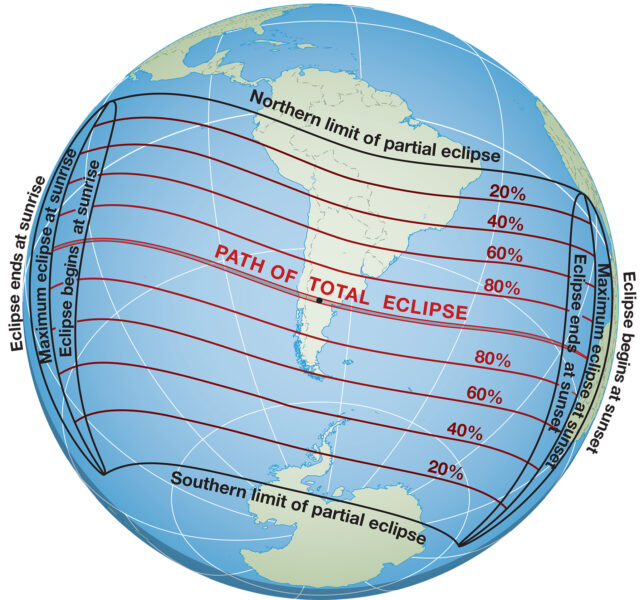
Gregg Dinderman / S&T; source: Fred Espenak
And then COVID-19 arrived, forcing the cancellation of virtually all of those group expeditions (including Sky & Telescope’s). But eclipse-chasers are a determined lot, and yesterday’s total solar eclipse proved how resourceful they can be just to get views of this celestial spectacle.
In Chile, pandemic-related travel restrictions eased in late November, allowing international flights to resume and tourists to enter the country under certain conditions. Many eclipse-chasers booked last-minute flights and headed for viewing sites in Pucón and Villarrica, nestled in the Andean foothills well to the south of Santiago. Meanwhile, Argentina’s more restrictive travel ban still allowed a few creative observers to make their way to the eastern (leeward) side of the Andes, which statistically offered the most-promising skies.
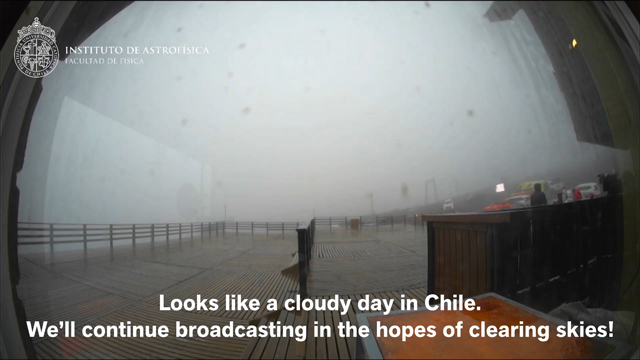
Instituto de Astrofísica / Pontificia Universidad Católica de Chile / Exploratorium
However, Mother Nature dished up a strong storm front that lashed southern Chile on eclipse day and sent hopeful observers scrambling for better conditions. Few succeeded. Alan Sliski, who traveled with a Williams College research team to Villarrica, wasn’t one of them. “The weather forecast was not good, so we drove to the Chilean border crossing with Argentina but got rained out. It was partly sunny in Pucón by the time we got back.”
Faced with a dire forecast, a small multinational group coordinated by TEI Tours and Travel scrambled to charter a pair of Cessna Citation business jets at the regional airport of Temuco. They intercepted the Moon’s umbra off the Chilean coast and managed to glimpse totality despite the Sun being nearly overhead. “The Citations have windows that are curved, slightly rising toward the ceiling,” explain passengers Alson Wong and Robert Stephens. “By lying on our backs and looking straight up, we could see the Sun well clear of the top of the windows.”
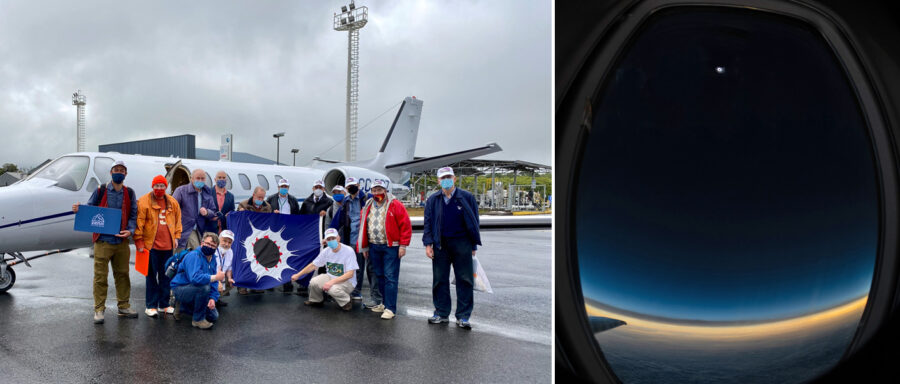
Robert Stephens
Clear(er) Skies in Argentina
Meanwhile, the weather was somewhat better across south-central Argentina, with generally clear skies but very strong winds. From the planned site for Sky & Telescope’s tour, a private ranch northeast of San Martín de Los Andes, local coordinator Santiago Uburu reported cloud-free skies for his “unbelievable” first view of totality.
Somewhat farther east, British-based tour leader Nick James reports, “We had a fantastic view from the Astro-Trails site near Piedra del Aguila. It was very windy but the sky was pretty clear except for some thin clouds which blew quickly across at 2nd contact.”
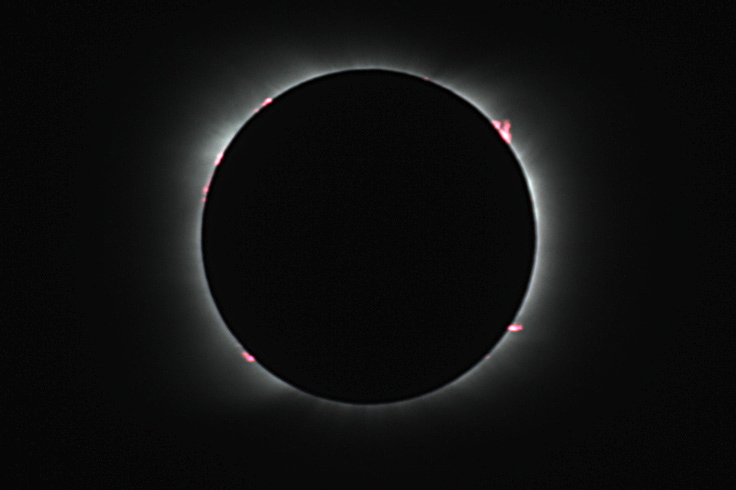
Eduardo Abello
A group with Colorado-based Sirius Travel were in the same general area, and tour leader Vicky Sahami says strong winds consistently blew at about 40 mph. Even so, she says, “We saw the planets beautifully including Jupiter and Saturn in close proximity to each other east of the Sun, Mercury close in and Venus was to the west. We saw spectacular shadow bands both before and after totality racing across the open dirt.” In fact, other observers report seeing shadow bands projected onto the thin clouds streaming overhead.
A number of organizations scrambled to offer live viewing during the eclipse. One particularly sad webcast from Villarrica showed gray skies and rain during the entire event — though it did get dark during totality. A well-produced webcast by CosmoSapiens offered multiple telescopic views of the entire eclipse from sites in Argentina.

cosmosapiens.com
Next Totality: December 2021
Over the past two decades, total solar eclipses have been evenly distributed, more or less, between the Northern and Southern hemispheres. That said, recently the region in and around South America has been favored, with the Moon’s shadow racing across Chile and Argentina in 2019, again in 2020, and one more time next December 4th.
But getting to the path of totality next year will be challenging — the only landfall is Antarctica and the tiny South Orkney Islands in the Scotia Sea. (Yes, if you insist, it’s possible to view totality from Antarctica.) Plenty of cruise ships ply these waters during that time of year, though weather prospects along the track aren’t particularly favorable.

Jay Anderson / eclipsophile.com
If you’ve always wanted to visit this part of the world, a total solar eclipse can certainly be a good excuse to do so! Sky & Telescope has two offerings that I’ll mention here briefly.
If you enjoy cruising, then I invite you to climb aboard the ms Roald Amundsen for an amazing 2½-week cruise. We’ll view the solar eclipse just after dawn from near the rugged, inhospitable South Orkney Islands. This is an “expedition” ship, equipped to glide closely along the Antarctic Peninsula and, yes, to allow its passengers to set foot on the world’s most extreme continent.
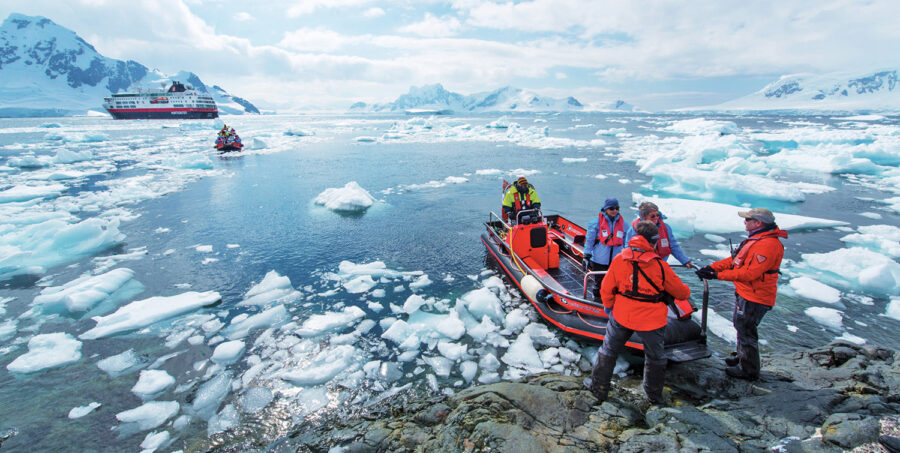
Hurtigruten
Or, if you absolutely, positively must see totality, then please check out our week-long tour of Chilean Patagonia that culminates with eclipse viewing at 38,000 feet aboard a chartered jet. All you have to do is get yourself to and from Santiago, and we’ll take care of the rest.
Honestly, watching a total solar eclipse via webcasts is OK — it’s better than nothing. But any eclipsophile will tell you that staring at a computer or smartphone screen is just a pale substitute for the real thing. And I’ll wager that, given the extended travel hiatus imposed on everyone since February, next year’s total solar eclipse will be a very popular destination. I, for one, can’t wait to be in the Moon’s shadow once again and to reacquaint myself with all the celestial delights of the southern sky.
 6
6
Comments
Arnaud
December 15, 2020 at 7:37 pm
A bit of math about that Sky&Telecope "dream cruise" for the 2021 total eclipse:
- one-way US -> Argentina air travel: 10 000km @ 0.1kg of CO2 / km / pax = 1 metric ton of CO2
- daily fuel consumption of a mid-sized cruise ship: 1/3 of a metric ton of fuel / pax which produces ca. 1 metric ton of CO2. The 2.5 week cruise disgorges about 14 metric tons of CO2 / pax
- one-way Argentina -> US air travel : another 1 metric ton of CO2 s pax
Total estimate of the "dream cruise" per pax: about 16 metric tons of CO2. Guys: you, S&T, me and the only planet where we can live simply can no longer afford this kind of "adventure". Wait for a nearby eclipse and stop going on the other side of the planet just to see an umpteenth eclipse.... We know they are all about the same anyways. And if you can't wait for the next nearby one, buy yourself an H-alpha filter.
High time to do things differently
Arnaud
You must be logged in to post a comment.
J. Kelly BeattyPost Author
December 16, 2020 at 9:03 am
hello, Arnaud . . . thanks for that perspective. you points are valid, though I'd point out that the Hurtigruten ship for our cruise employs a hybrid propulsion system with much-reduced CO2 emission.
You must be logged in to post a comment.
Anthony Barreiro
December 16, 2020 at 5:00 pm
I wasn't going to say anything, and I'm not so good at math, but I had the same thought as Arnaud. We all have varying degrees of privilege, and we all make different choices about how we use resources. I've never been to the southern hemisphere, and I hope to travel there someday to see the southern constellations. So I'm not going to tell others what to do, but I hope we will all be mindful of our impacts and try to be as kind to the planet and future generations as possible.
You must be logged in to post a comment.
Alain Maury
December 19, 2020 at 1:03 pm
While we are at it, we could also stop saying things like "kind to the planet". Looks to me like the planet doesn't care much. In the worst case scenario, we continue to pollute like crazy, global warming gets crazy, we have wars, hunger, pandemia, etc...(I mean things we already have, but a much higher level). Humanity dissapears, in less than a million year, the planet is back to normal, except without humans. We ought to be kind to us, not to the planet.
You must be logged in to post a comment.
Anthony Barreiro
December 24, 2020 at 4:44 pm
Alain, you're better at reading the mind of planet Earth than I am. Would you go so far as to say that we should be kind to the other species who live on the planet?
https://www.pnas.org/content/117/24/13596
You must be logged in to post a comment.
Guillermo Abramson
December 24, 2020 at 1:41 pm
Hi all. Completely clear skies in Piedra del Águila (Neuquén). Fantastic eclipse, very different from last year's. The corona was more radially symmetric, and with prominences all around. I imagine these are signs of the Sun moving away from the minimum of activity. also, the corona was of a fiery silver white, very different form the nacred one of last year's.
See a selection of images at https://www.flickr.com/photos/12759894@N06/
Guillermo
You must be logged in to post a comment.
You must be logged in to post a comment.